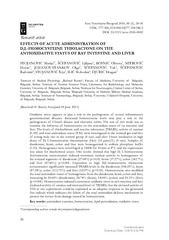Приказ основних података о документу
Effects of Acute Administration of D,L-Homocysteine Thiolactone on the Antioxidative Status of Rat Intestine and Liver
| dc.creator | Stojanović, Marija | |
| dc.creator | Scepanovic, Ljiljana | |
| dc.creator | Bosnic, Olivera | |
| dc.creator | Mitrovic, Dusan | |
| dc.creator | Jozanov-Stankov, Olga | |
| dc.creator | Scepanovic, Vuk | |
| dc.creator | Scepanovic, Radomir | |
| dc.creator | Stojanovic, Teja | |
| dc.creator | Ilic, Slobodan | |
| dc.creator | Đurić, Dragan M. | |
| dc.date.accessioned | 2018-03-01T16:57:37Z | |
| dc.date.available | 2018-03-01T16:57:37Z | |
| dc.date.issued | 2016 | |
| dc.identifier.issn | 0567-8315 | |
| dc.identifier.issn | 1820-7448 | |
| dc.identifier.uri | https://vinar.vin.bg.ac.rs/handle/123456789/1117 | |
| dc.description.abstract | Oxidative stress appears to play a role in the pathogenesis of several inflammatory gastrointestinal diseases. Increased homocysteine levels may play a role in the pathogenesis of Chrons disease and ulcerative colitis. The aim of this study was to examine the influence of homocysteine on the antioxidant status of rat intestine and liver. The levels of thiobarbituric acid reactive substances (TBARS), activity of catalase (CAT) and total antioxidant status (TAS) were investigated in the isolated gut and liver of young male rats in the control group (8 rats) and after 3-hour incubation in high doses of D, L-homocysteine thionolactone (Hcy) (10 mu mol/L) (8 rats). Samples of duodenum, ileum, colon and liver were homogenized in sodium phosphate buffer (1: 10). Homogenates were centrifuged at 10000 for 10 min at 4 degrees C and the supernatant was taken for biochemical assays. Our results showed that high D, L-homocysteine thionolactone concentration reduced enzymatic catalase activity in homogenates of the isolated segments of duodenum (27.04%) p LT 0.01; ileum (37.27%), colon (34.17%) and liver (67.46%) p LT 0.001. Exposition to high D, L-homocysteine thiolactone concentration significantly increased TBARS levels in the duodenum (106.05%), ileum (47.24%), colon (112.75%) and liver (32.07%) (p LT 0.01). Homocysteine also modified the total antioxidant status of homogenates from the duodenum, ileum, colon and liver, increasing by 20.68% (duodenum), 24.74% (ileum), 14.88% (colon) and 19.35% (liver) (p LT 0.001). Homocysteine induced a consistent oxidative stress in rats intestine and liver (reduced activity of catalase and increased level of TBARS), but the elevated activity of TAS in our experiments could be explained as an adaptive response to the generated free radicals which indicates the failure of the total antioxidant defense mechanism to protect the tissues from damage caused by homocysteine. | en |
| dc.relation | info:eu-repo/grantAgreement/MESTD/Basic Research (BR or ON)/175043/RS// | |
| dc.rights | openAccess | en |
| dc.rights.uri | https://creativecommons.org/licenses/by-nc-nd/4.0/ | |
| dc.source | Acta Veterinaria, Beograd | en |
| dc.subject | antioxidant enzymes | en |
| dc.subject | homocysteine | en |
| dc.subject | lipid peroxidation | en |
| dc.subject | oxidative stress | en |
| dc.title | Effects of Acute Administration of D,L-Homocysteine Thiolactone on the Antioxidative Status of Rat Intestine and Liver | en |
| dc.type | article | en |
| dc.rights.license | BY-NC-ND | |
| dcterms.abstract | Сцепановиц, Радомир; Сцепановиц, Вук; Илиц, Слободан; Стојановиц, Теја; Дјуриц, Драган; Стојановиц, Марија; Јозанов-Станков, Олга; Сцепановиц, Љиљана; Митровиц, Дусан; Босниц, Оливера; | |
| dc.citation.volume | 66 | |
| dc.citation.issue | 1 | |
| dc.citation.spage | 26 | |
| dc.citation.epage | 36 | |
| dc.identifier.wos | 000377780400002 | |
| dc.identifier.doi | 10.1515/acve-2016-0002 | |
| dc.citation.rank | M23 | |
| dc.type.version | publishedVersion | |
| dc.identifier.scopus | 2-s2.0-84962784582 | |
| dc.identifier.fulltext | https://vinar.vin.bg.ac.rs/bitstream/id/4887/bitstream_4887.pdf |

